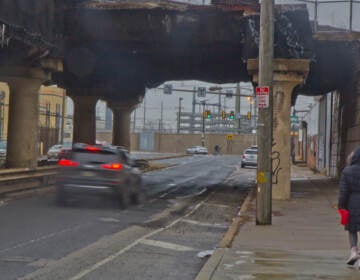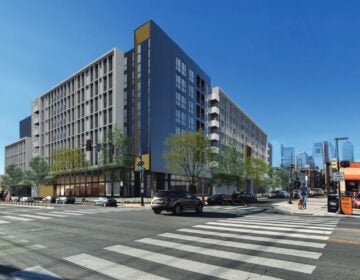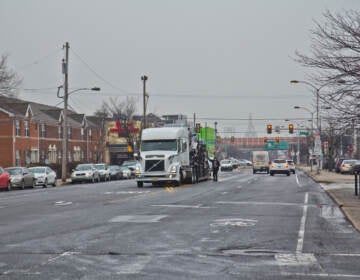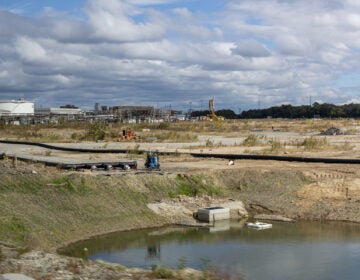Washington Avenue planning chaos ends with city choosing hybrid design
The city’s final design to narrow a busy section of Washington Avenue will be a mix of three, four, and five lanes.

An open house in South Philly, where transportation officials presented the final plan, was at capacity. (Sophia Schmidt/WHYY)
Nearly two years after releasing a “final design decision” for the controversial Washington Avenue redesign, city transportation officials have settled on a hybrid design they say better addresses concerns about traffic overflowing onto residential streets. The plan to narrow the busy thoroughfare in South Philadelphia could be implemented as soon as this summer.
“This approach is going to substantially improve the safety over what people see today, and that’s the main goal that we’ve had all along,” said Deputy Managing Director for Transportation, Infrastructure, and Sustainability (OTIS) Mike Carroll.
Carroll told reporters Tuesday morning that the city will pursue a hybrid design where four blocks remain at their current width of five lanes, eight blocks narrow to four lanes, and 10 blocks narrow to three lanes. Crossing distances will shrink from their current 50 feet to 33 or 40 feet. Officials chose the option over a primarily four-lane design announced as the only other possibility last month — a change from the department’s stance two years ago.
The city’s planning process has sparked anger from both proponents of a bike- and pedestrian-friendly Washington Avenue and those who think the road should continue to favor drivers and businesses.
Champions of the primarily three-lane design announced as “final” in 2020 felt betrayed when the city walked back the decision in February, after holding a series of in-person conversations with residents officials said were left out of the initial public input process, as well as bike advocates and urbanists. Some longtime residents opposed the narrowest solution, fearing fewer travel lanes would push traffic onto nearby residential streets. The debacle played out against the tensions of a gentrifying neighborhood.
Carroll said Tuesday that the hybrid design balances competing visions for Washington Avenue between 4th Street to Grays Ferry Avenue, where construction supply stores, vacant lots, and modest rowhomes coexist with towering luxury apartment buildings.
“What we had come up with works pretty well in balancing both the traffic safety concerns, but also the traffic flow concerns,” Carroll said.
The hybrid design also includes bus boarding islands and 18 blocks of protected bike lanes.
OTIS plans to pair the repaving and lane reconfiguration with additional traffic calming tactics, such as speed cushions and automated red light cameras, as well as signal timings that give people crossing the street a head start over turning cars. Carroll said many of the crashes involving pedestrians happen when drivers are turning on or off of Washington Avenue — so the city will also try rumble strips and so-called “corner wedges” that dictate drivers’ turning radius.
“Generally speaking, that does enough to dissuade folks from taking those turns at speed,” Carroll said.

People had to be turned away from an open house Tuesday at the Christian Street YMCA in South Philadelphia, where city transportation officials presented the final design.
Most attendees seemed unhappy with the hybrid design, despite its mix of narrow and wide blocks. Carroll presented the plan over dissatisfied shouts.
People who continue to support a mostly three-lane design held signs calling for a safe Washington Avenue. Among them was Jane Roosa, who moved to the area six months ago.
“Washington is always a difficult road to cross,” she said.
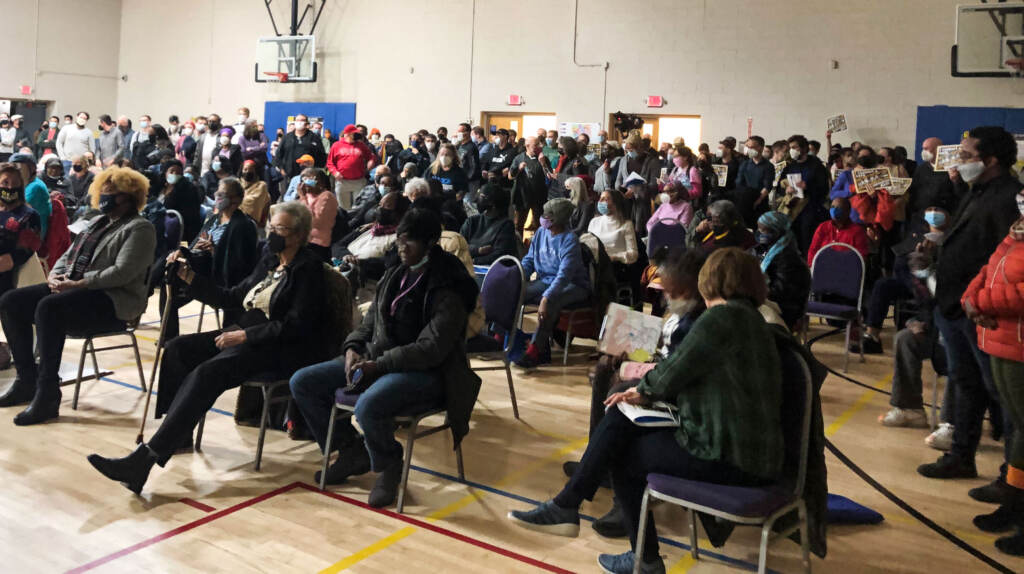
People who want to see the road stay wider stuck to their position as well. Claudia Sherrod, one of the loudest voices opposing the three-lane design, said the hybrid solution does not feel like an appropriate compromise.
“No three, period,” she said. “Because you’ve got businesses that will lose their business.”
Cynthia Fordham is one person who sees the design as a compromise she can live with.
The longtime South Philly resident has crossed Washington Avenue for over 50 years — and hasn’t found it more dangerous than other areas of the city.
“I think [the hybrid design] will make things safer, but also help the people who’ve always been here in the different streets,” she said.
Brianna Baker of East Passyunk also saw benefits in the final design, although she preferred the three-lane solution.
“We are excited about the bus boarding islands, are excited about the corner wedges, so it’s nice to see that there will be some safety improvements,” she said. “But overall, I would have liked to see the safest plan passed.”
Before the city can implement the lane reconfiguration, officials with OTIS want to see City Council approve changes to parking and loading regulations that would encourage more turnover of parked vehicles, Carroll said. In order for the repaving to happen this summer, the legislation would need to make it through council before the end of its spring term in late June.
Councilmember Mark Squilla, who represents part of the project area, said at the open house that he’s “not sure” whether the timeline OTIS seeks is realistic.
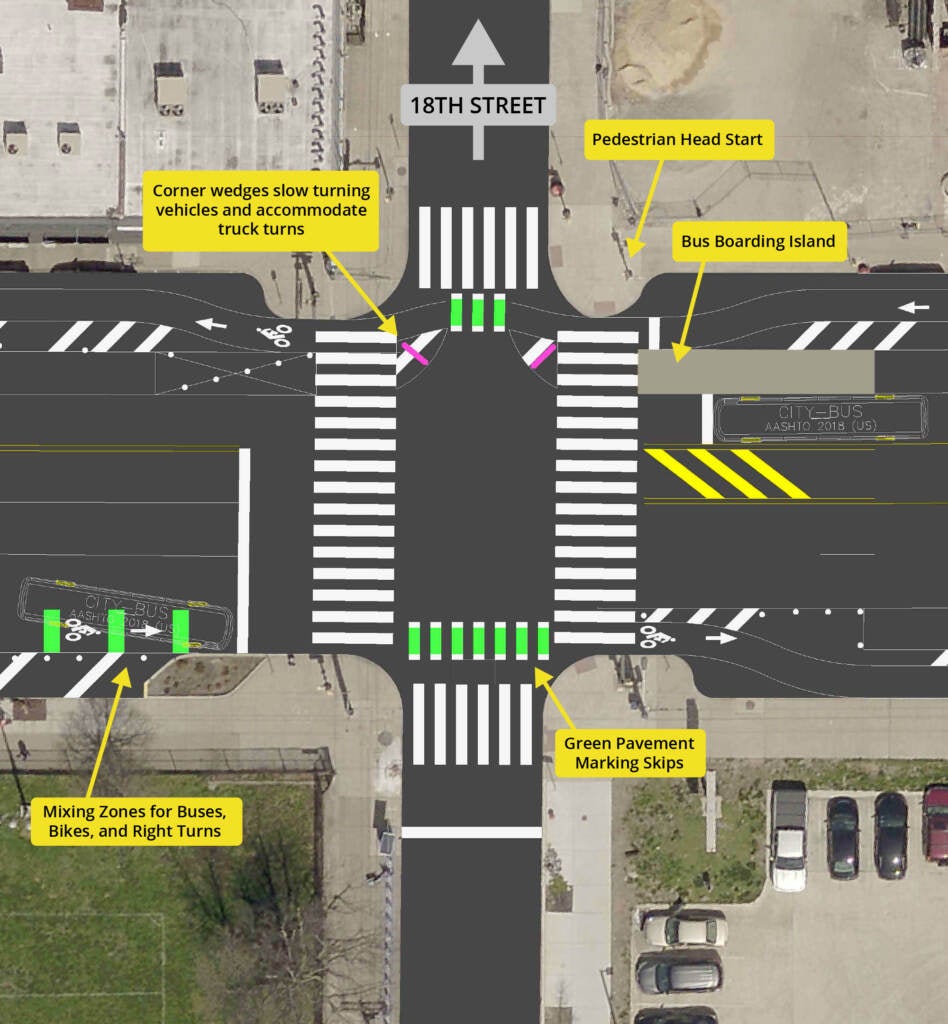
“It seems like right now, nobody’s happy with the plan, no matter what side you’re on,” he said. “But, you know, we have to make Washington Avenue safer for everybody. So I think at the end of the day, there will be a plan that moves forward.”
Vincent Thompson, a spokesperson for Councilmember Kenyatta Johnson, said Tuesday afternoon his office had not seen OTIS’ proposed parking and loading regulations, and could not yet commit to supporting them.
The lane reconfiguration was not up for debate Tuesday, but Carroll encouraged residents to give their input as the parking and loading regulations make their way through council.
“It’s not news to us that not everybody’s happy with this plan,” he told the crowd. “We feel like under the circumstances, given the fact that for 10 years we’ve been talking about Washington Avenue, it’s time to move on to the next chapter.”

Subscribe to PlanPhilly
WHYY is your source for fact-based, in-depth journalism and information. As a nonprofit organization, we rely on financial support from readers like you. Please give today.





